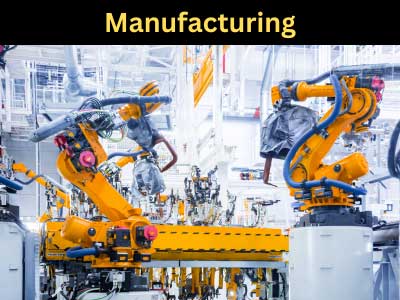Key Takeaway
Using augmented reality (AR) in manufacturing offers significant benefits, including enhanced productivity, accuracy, and safety. AR allows workers to visualize complex processes, overlaying digital instructions directly onto physical objects, which reduces errors and speeds up assembly and maintenance tasks. This technology also helps in detecting potential faults early, improving workflow procedures, and optimizing maintenance operations by providing real-time, step-by-step guidance.
Furthermore, AR enables remote collaboration, allowing experts to assist workers from different locations, which reduces downtime and improves efficiency. Overall, augmented reality is revolutionizing manufacturing by making operations more efficient, accurate, and safe.
Introduction to Augmented Reality in Manufacturing
Augmented reality (AR) is quickly becoming a valuable tool in modern manufacturing, offering new ways to enhance production, improve design, and optimize worker training. By overlaying digital information onto the physical world, AR allows engineers and operators to visualize complex data, instructions, or designs in real-time, directly within their working environment. Unlike virtual reality, which creates a completely digital space, AR integrates the virtual with the physical, making it highly useful for tasks that require interaction with real-world objects.
For newly-joined engineers, AR can revolutionize how they approach complex manufacturing tasks, giving them a deeper understanding of machinery, processes, and designs. As manufacturing continues to evolve, integrating AR solutions will become crucial to staying competitive, as it enables more efficient workflows and enhances precision in day-to-day operations.

Enhancing Product Design and Prototyping with AR
One of the primary benefits of augmented reality in manufacturing is its impact on product design and prototyping. Traditionally, creating physical prototypes has been time-consuming and costly. However, AR allows designers and engineers to visualize product concepts in 3D, without needing to build actual models. This enables manufacturers to quickly iterate on designs, identifying potential issues and making necessary adjustments before moving into production.
With AR, designers can superimpose digital models onto physical objects, giving them a realistic view of how the final product will look and function in a real-world setting. This level of detail speeds up the design process, reduces the time spent on revisions, and minimizes costs associated with physical prototyping. Engineers can also collaborate more effectively with teams across different locations by sharing and reviewing AR-enhanced designs in real-time.
In summary, AR transforms the way manufacturers approach product development by streamlining design processes, reducing costs, and ensuring more accurate outcomes, all of which contribute to faster time-to-market for new products.
Training and Skill Development Using AR
Training employees to operate advanced machinery or follow new production processes can be challenging and expensive. However, augmented reality simplifies this by offering immersive, hands-on training experiences without the need to disrupt actual production. AR can overlay step-by-step instructions on machinery or production lines, allowing workers to follow detailed guidance in real-time. This method accelerates learning and reduces the potential for mistakes during live operations.
For new engineers, AR-based training provides a safer and more engaging way to gain practical experience. It allows trainees to explore and interact with virtual components, gaining confidence before working on the real equipment. AR simulations can also be used to create complex scenarios, such as troubleshooting or repairing machines, without putting production at risk.
This approach significantly reduces the time required to train employees and increases retention of knowledge. By providing a visual and interactive training environment, AR ensures that workers are better prepared, leading to fewer errors and improved overall efficiency in manufacturing operations.
AR for Real-Time Maintenance and Support
Augmented reality is a game-changer when it comes to equipment maintenance and troubleshooting. Traditionally, maintaining complex manufacturing systems requires expert technicians, and any delay in their availability can lead to costly downtime. With AR, maintenance becomes more efficient, as technicians can receive real-time support, guidance, and diagnostics directly through AR-enabled devices like smart glasses or tablets.
AR can display critical information, such as the operational status of machinery, potential faults, and step-by-step repair instructions, directly onto the equipment. This allows less-experienced technicians to perform complex repairs with confidence, reducing reliance on external experts. In cases where expert help is required, AR enables remote support, where specialists can guide on-site workers in real-time, minimizing downtime.
For engineers in the manufacturing field, AR enhances the ability to quickly identify issues, perform preventive maintenance, and resolve problems efficiently. This reduces machine downtime, improves productivity, and extends the lifespan of equipment, making AR an essential tool for modern maintenance operations.
Increasing Productivity and Reducing Errors with AR
In manufacturing, even small errors can lead to costly delays and waste. Augmented reality helps prevent these errors by providing workers with real-time information and visual guidance during production. For instance, AR can project assembly instructions directly onto parts, ensuring that workers follow precise steps and avoid mistakes. This reduces the need for rework and ensures that products are assembled correctly the first time.
AR also improves communication between teams. For example, a manager can use AR to share instructions or updates instantly with all employees, without interrupting the production process. This helps keep everyone aligned with the latest changes and ensures that operations run smoothly. Additionally, AR allows engineers to visualize data related to production performance, identifying inefficiencies and optimizing workflows.
By using AR to streamline tasks, manufacturers can significantly increase productivity. Workers are empowered with the tools they need to make fewer mistakes, complete tasks faster, and ensure higher levels of accuracy throughout the production process.
Conclusion
Augmented reality is rapidly transforming the manufacturing industry, offering substantial benefits in product design, employee training, maintenance, and overall productivity. By integrating AR into manufacturing processes, companies can enhance efficiency, reduce errors, and optimize workflows, all while lowering costs. For engineers and workers alike, AR provides a powerful tool that improves understanding, accelerates learning, and ensures real-time support. As the technology continues to evolve, AR will play an even greater role in shaping the future of manufacturing, making it smarter, faster, and more precise.
